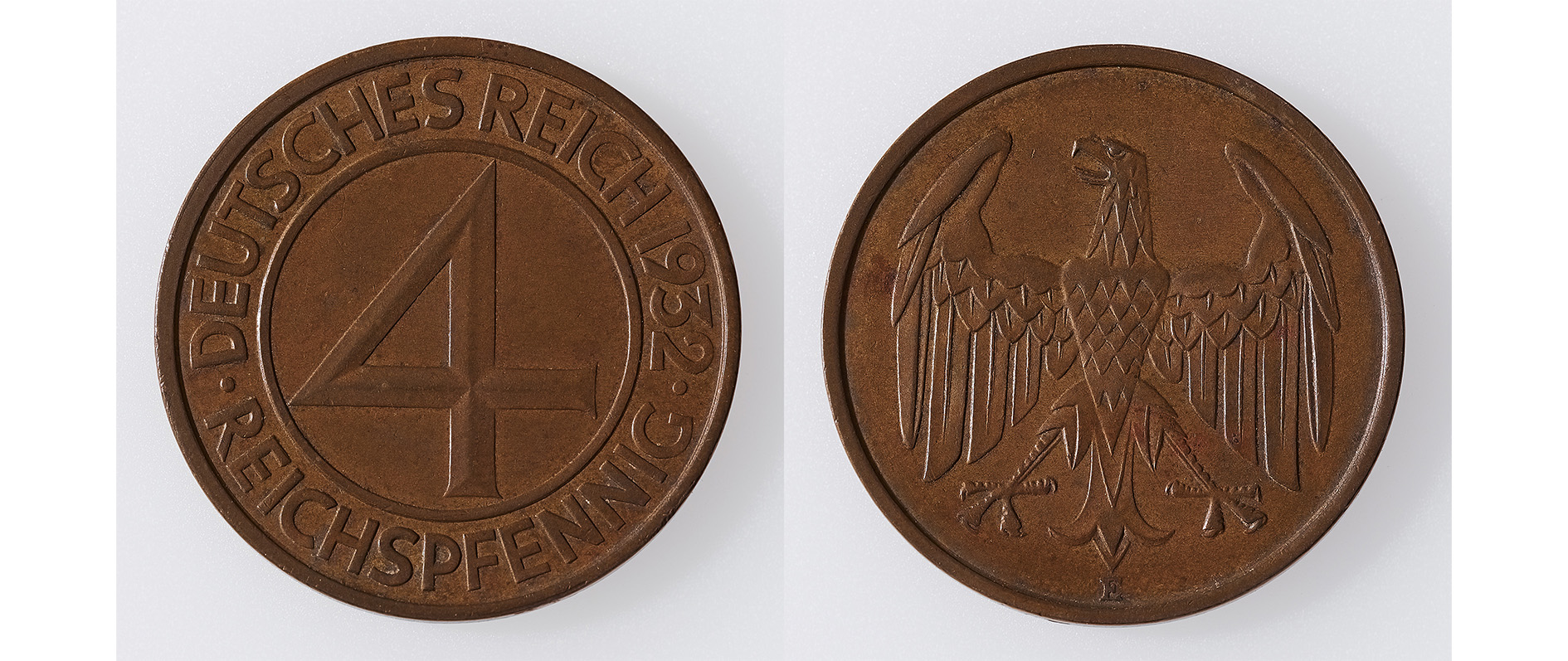
What’s that for? A 4-Pfennig Coin
Nico Geisen | 03. Februar 2023
In its material and size, the so-called Brüning thaler is rather inauspicious. However, for a time, great hopes were placed in this coin, which is on display in the exhibition “Roads not Taken. Oder: Es hätte auch anders kommen können”: it was supposed to help to overcome the crisis of the German economy at the end of the Weimar Republic. This was to be achieved through the coin’s special nominal value. Nico Geisen, research trainee in the DHM’s department of collections, explains the political idea behind the coin.

When the Berlin newspaper “Der Tag” advertised a prize for the cleverest name for the newly launched penny, the readers proved themselves very resourceful: “Aid kreuzer”, “Prole dollar”, “Bankruptcy groschen”, etc.[1] It is remarkable that among the many names submitted, none took reference to the look of the coin. This is not surprising considering the ordinary lettering and common symbolism of the imperial eagle. With a diameter of 24 mm, the copper coin was hardly any different from other Reich pennies or annuity marks of the time.[2] The nicknames suggested by the readers tended to refer to the coin’s political implications, which were marked above all by deflation.
Reich Chancellor Heinrich Brüning’s deflationary policy was promoted above all by the Centre Party. At the beginning of his term of office in 1930, the “golden years” of the Weimar Republic came to an end. An economic depression was in the making. The New York stock exchange crash in October 1929 triggered a worldwide crisis, and the highly debt-ridden German Reich was unable to borrow money.
The German economy was subject to alarmingly wild fluctuations, which led to a steady deterioration in monetary stability. The disparity between prices and wages grew out of proportion so that the purchasing power of the Germans dropped from an average of 1,185 RM in 1928 to 716 RM in 1932. In the same period of time the unemployment rate of the entire population rose from 7 % to 30,8 %.[3]
The stated aim of Brüning’s government was therefore to reduce wages and prices, which was to be achieved through far-reaching austerity measures. Wages in the general economy were to be reduced so that companies could hire more workers. The market prices would be adjusted to the wages and bring about a general deflation, as the government hoped. Brüning aimed for a 20 % devaluation of the Reichsmark in order to generate an export surplus, which would bring more foreign currency into the Reich.[4] The aim was to stimulate the savings behaviour of the population.
The introduction of the 4-pfennig coin was one means of achieving this. It was linked with the hope of making it easier for people to calculate in pennies. It was intended to guide the people into a dual digital payment system with 2 and 4 pfennigs instead of the decimal system of 5 and 10 pfennigs. The government hoped that consumers world prefer the dual payment system so that dealers would adjust their prices to the 4-pfennig piece.

However, the Reichsbank had difficulties trying to get the population to accept the new penny. Public institutions and banks did not order the 4-pfennig coin. Many of the 50 million pennies that were circulating were exchanged by the Reichsbank. People were afraid of losing their assets and refused to use the coin. In a final act of desperation, Brüning’s government even ordered that when the salaries of public employees were paid out, they would include two Reichsmarks worth of 4 pfennig pieces. That, too, did not have the desired effect. In a malicious aside aimed at Brüning’s politics, the chancellor’s forename was mockingly adopted for the pfennig coin: “Poor Heinrich”.
After its introduction on 1 February 1932, the 4-pfennig coin remained in circulation for less than two years. It was one of several emergency decrees that were adopted, together with a whole package of further austerity measures. In March Brüning even planned to enact another emergency decree, which was to include cutbacks in social services as well as a job-creation programme for 600,000 people. Before the Reichstag he claimed that he stood only “100 metres before the finish” [5] in saving Germany from the financial crisis. But before he got to the finish line, Reich President Paul von Hindenburg refused to sign further emergency decrees.
Brüning had squandered his trust. He steadily lost the support of politicians and the citizens. Without further emergency decrees and in the face of his political opponents, he was no longer in a position to govern and resigned as chancellor on 30 May 1932. After taking power, the National Socialists withdrew the 4-pfennig coin from circulation in an emergency decree dated 18 March 1933.
[1] Cf. Jaeger, Kurt, Die deutschen Münzen seit 1871 mit Prägezahlen und Bewertungen, bearb. v. Udo Helmig u. Helmut Kahnt, Basel 1997, p. 311.
[2] For further information on the introduction of the annuity mark (Rentenmark), see LeMO: Scriba, Arnulf, Die Währungsreform 1923, https://www.dhm.de/lemo/kapitel/weimarer-republik/innenpolitik/waehrungsreform-1923.html, last accessed: 17.10.2022.
[3] Cf. Golla, Guido, Zielvorstellungen und Auswirkungen der Brüningschen Sparmaßnahmen, Köln 1994, pp. 6-13.
[4] Cf. Brüning, Heinrich, Memoiren. 1918-1934, Stuttgart 1970, pp. 474-477.
[5] Wilhelm Vernekohl, Rudolf Morsey (ed.), Heinrich Brüning, Reden und Aufsätze eines deutschen Staatsmanns, Münster 1968, p. 164.
|
Foto: DHM/Thomas Bruns |
Nico GeisenNico Geisen is a research volunteer in the Department of Collections. |
